#Low and high-poly 3D design
Explore tagged Tumblr posts
Text
Revolutionize Your Product Displays with 360 Furniture Modeling Services
The furniture industry is evolving rapidly, and staying ahead of the competition requires innovative solutions that captivate your audience. One such groundbreaking innovation is 360 furniture modeling services. At 3D Furniture Modeling Studio, we specialize in creating lifelike, interactive 3D furniture models that allow your customers to explore products from every angle.
What Are 360 Furniture Modeling Services?
360 furniture modeling involves the creation of high-quality, detailed 3D models of furniture pieces that can be rotated and viewed from all angles. These models provide a comprehensive view of the product, highlighting every curve, texture, and finish in stunning detail. Whether for e-commerce, marketing, or design purposes, these models deliver a truly immersive experience.
Why Are 360 Furniture Models a Game-Changer?
In a world driven by visual content, static images no longer suffice. Here’s why 360 furniture models are essential:
Enhanced Customer Experience: Interactive models allow customers to inspect products as they would in person.
Greater Transparency: By showcasing every detail, customers gain confidence in their purchasing decisions.
Increased Engagement: Interactive elements keep users on your platform longer, boosting brand interaction.
Competitive Edge: Stand out with cutting-edge visuals that set your brand apart.
Industries Benefiting from 360 Furniture Modeling Services
360 furniture modeling isn’t just for furniture retailers. It offers value across multiple industries:
E-Commerce Stores: Drive sales by letting customers explore products online as if they were in a showroom.
Interior Designers: Present your vision to clients with dynamic 3D furniture models.
Manufacturers: Display your product line with precision and style, attracting buyers and distributors.
Key Features of Our 360 Furniture Models
At 3D Furniture Modeling Studio, we focus on creating models that deliver impact:
Photorealistic Details: Textures, materials, and finishes that replicate the real product.
Smooth Rotation: Seamless and interactive 360-degree views for an engaging user experience.
Customizable Backgrounds: Add realistic environments or plain backgrounds as per your needs.
Compatibility: Models optimized for integration with websites, apps, and virtual reality platforms.
Why Choose 3D Furniture Modeling Studio?
We are pioneers in 360 furniture modeling services, offering:
Expertise: A skilled team dedicated to crafting precise and detailed models.
Innovation: Use of advanced tools and software for superior results.
Customization: Models tailored to meet your specific business needs.
Reliability: Timely delivery without compromising quality.
The Impact of 360 Furniture Models on Sales and Marketing
Studies show that interactive content can boost conversion rates significantly. With 360 furniture models:
Customers spend more time on product pages, increasing engagement.
Trust levels rise as customers feel more informed about the product.
Sales improve due to the enhanced shopping experience.
#3D Furniture Silo Rendering#3D Furniture Lifestyle Rendering#3D Product Rendering#3D Furniture Animation#Product Animation#360° Product View#High-Poly 3D Modeling#Low- Ploy 3D Modeling#Furniture Modeling for AR#Product Modeling for AR#high-poly 3d modeling services#Low-Poly 3D Modeling#Low-poly 3d modeling services#Low and high-poly 3D design
1 note
·
View note
Text
i need to think of a hc to write about so i can rotate devan around in my brain in a productive way
#❚ ooc#its just a low poly 3d version drifting around rn....#mostly thinking about art things to do with them#like finishing their stupid ref (i decided to design the back of their outfits....)#what if i did a painting practice of them in the arcane style.... woag#general yapping in the rest of the tags before i close my puter down#i saw that new movie with the aliens in it tonight which isnt the vibe for my fantasy cult priest but!!!! horror is idk#mad i cant think of a good way to incorporate devan into the odyssey verse im trying okay#a templar? a newly promoted ordinal?? a second in command to a crimelord with cult-like themes???#also cause im obsessed with high noon right now im pondering how i would place them in that verse too... a zealot to the fallen angels?#do they believe the world needs to burn to be reborn? what about a reverend in a devil's deal? i dont knoowwww#see if i had headcanons or worldbuilding things to work on i wouldnt be struggling with these ideas
2 notes
·
View notes
Note
Currently in game dev as a student and I’ve been looking over your art and concepts for a little bit now—I’m FLOORED. I haven’t checked on your art in a while and had forgotten just how much it inspires me.
Your style holds so much identity, and your skill bleeds through every brushstroke! The way you do silhouettes, the insanely unique and beautiful choice of colors, the ferocity in some of the expressions, the quality of your brushwork, again the USE OF SILHOUETTE AND FORM OH MY GOODNESS!!!
You have SUCH a striking visual style and the way you incorporate similar themes to tie character designs together in your world is incredible! I was able to pick out what I believed to be symbolism and understand it a few seconds after asking the question (it may have been explained in the text and I missed it, but the fact that I was able to draw a conclusion that quickly says a lot about your skills as a designer and artist!).
Please forgive me if this has been asked before by the way, but what program do you use? I have a number of them and am trying to work out how you managed to get the line quality that you do on the brushstrokes (they’re like. Creamy looking??? Does that make sense? They blend together very nicely but don’t blend so much that it muddies the contrasting colors you put on top.)
Anyways as I was reading the game idea you have, I was actively trying to envision how it would look and was immediately feeling a 3D-2D mixed style, especially since your artwork has a very clear visual identity that would benefit from being the focus rather than something like plain or simplistic 3D models.
And then I immediately stumbled onto the low poly model you made and fell in love. I had already thought a Disco-Elysium inspired + low poly (less development time, plus requires less budget for an indie project) would look amazing especially considering how your brushwork means that high-poly models might not benefit nearly as much from it. And I think it might be the right call to continue with that!
What perspective (2D/platformer, 2D platformer with depth [Ex. “Paper Mario”] top down, isometric, 3rd person, 1st person, etc.) do you envision when you think of your game idea?
Personally I feel like it’d work as a 3rd person perspective 3D game, but using extremely low poly buildings and set pieces that let the textures do the work. But keeping in mind that if every character is 3D and rigged, it can and will still take monumentally more time to make.
I could also see it going the direction of having flat 2D characters in a 3D environment (Like “Smile For Me”) which would take less development time and save more energy to focus on good gameplay.
I’d love to hear more about your ideas, and think that you should definitely give more thought to making that game a reality!
Just as a word of advice though, start small. ;^^ Don’t begin with your dream project, make some goofy little games first to get your feet in the water, then dive in once you have that experience. And don’t get too wrapped up in it either, take breaks and divert from the project every so often to regather your creative energy. Like doing game jams for example!
o7
first of all thank you for such a LONG text oh my god T_T I cannot express in words how much this means to me and even if I knew English well, I still wouldn't be able to tell you... I use drawpile a lot for sketches and light stuff like doodles! And Photoshop for more complicated works and render. If you need brushes I have them in this post on my side acc. As for ynstbh, well... Here goes the rambling haha. I was thinking about it being either 2d platfomer /LISA was my main inspiration at the start/ or isometric 3D thing. Isometric still wins in my head because it gives some space for movement in different planes, if that makes sense, my favorite example of it being player is walking through the City and at some point you see a tower on a foreground plane just getting up and running off the screen to ambush you later haha (yes, the City is like that. nothing unusual here). When this game idea first appeared in my head, I also wanted it to have some kind of frame, medieval-inspired, around the gameplay, that would change drawings depending on the location. But now I think that's gonna be too much visual noise. And I would love to make cutscenes because I like my 3d models and I like to animate stuff, although it would take an abysmal about of time to make backgrounds.. Also ynstbh would probably have a lot of dialogues, since I really love to show characters through their interactions with each other. Notably the Devil, who loves to break the 4th wall and look right at the player in his portraits.
Either way yeah, I know about starting small. Right now I only have experience in drawing, 3d, just a little bit of code (I think I forgot everything actually lol) and I'm just really good at googling problems. I hope somewhere in the future I will have enough energy to start. My lore and characters became really important and dear to me so I really hope to make sth with them. :) If game doesn't work out, I'm thinking to give an animated short a chance, I need to put this world somewhere or I'll probably go insane. Once again thank you and good luck with your studies! thanks for letting me ramble about ynstbh haha <3
86 notes
·
View notes
Text

A strange flower that quietly promises great treasures... But only during panic mode... Bassie's whispering flower!
This trinket was a really interesting one to make, so I've included some extra commentary beneath the cut for anyone interested!
After making Glisten's mirror, I decided that if I was going to continue modelling the trinkets I would have to continue to make them as low poly as I could. The reason behind this is that, for rendering purposes, it's much easier to take a lower poly model and apply a subdivision modifier to it than it is to make a high poly model and retopologize it (like I did with Glisten's mirror). Given that the flower is decidedly much more organic than a mirror, trying to make it read as organic while also keeping the poly count down seemed... challenging. And it was! But I eventually figured it out.
It all started with interpretting the flower's design. The way the trinket is posed in-game doesn't reallllly do a good job of conveying how the flower is constructed. You can tell what it is, yes, but how the flowers are connected to each other (if they're even connected at all) is unclear.

At first, I thought the flowers were connected end to end by the same stem, catdog style. While that would have been easier to model, I feel like it would have looked very silly in 3D, so I went with my other interpretation, which is that the trinket is 2 flowers connected at the base, viewed from the top down. I also added ichor-drenched roots to the design to:
Call back to the conditions to get the trinket (100% research on twisted Bassie, so you could think of it as a flower taken from her basket)
Make the design feel more complete, since it felt weird to have just the plant but no roots that would have attached it to the ground. Plus, including the roots gives it a more brutal nature, as if it was roughly pulled out of the dirt.
Make myself suffer.
When it came to modelling, nothing was particularly hard to model, but troubles arose when trying to keep the model optimized. The petals and leaves posed no issues, but the stems and roots...
To provide context, the way I initially modeled those parts using the skin modifier. Imagine you have a piece of string. What the skin modifier does is that it thickens up that string, and if you make it thick enough you can easily make tube-shaped objects such as stems and roots really easily. The skin modifier is especially strong because you can change the thickness of the "string" at any point (which was good for making the tapered ends of the roots). However, when it comes to optimizing models, the skin modifier tends to produce models which can be more detailed than I'd like.
I still ended up using the skin method for the roots, but for the stems, I used curves. Using curves achieves a very similar effect to using the skin modifier, however it offered me better control of how detailed the stems should be.
Pictured below is the different between using the skin modifier and curves. While the skin modifier produces a result that is physically smoother, the curves method produces a result thats a little blocky but is much better in poly count. The curves method is also the one used in the final render, and you probably couldn't tell that it was that blocky thanks to Blender's "shade smooth" option, which I assume is also used in game.
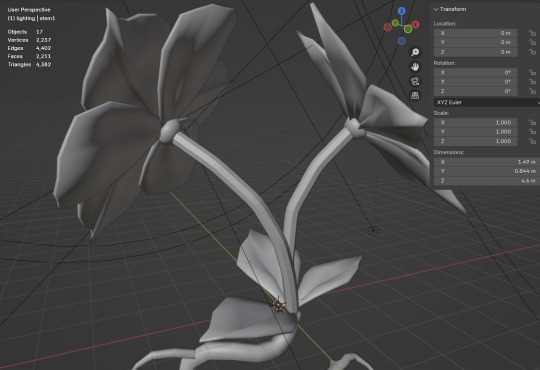
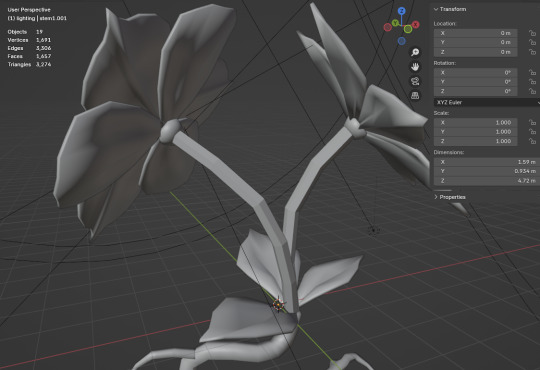
Congrats for reading all the way to the bottom! As a reward you get two (2) still renders of this flower.


#dandys world#dandys world fanart#dw bassie#bassie dandys world#dandys world bassie#bassie dw#art#digital art#3d modeling#3d#3d art#3d model#artists on tumblr
54 notes
·
View notes
Text
In the past few weeks, I've switched a bit to 3D art. Just graduated from Game Design uni and realised I don't actually know how to do this properly smh.
I started him (neither Ingo nor Emmet yet, in which state I like to call him Jürgen) because I got sick and tired of drawing all that animatronic geometry every single time I made a submas animatronic. So this was meant to be a posing dummy for that.

As one does I started with a T-posing guy, luckily having a 2D reference of Ingo on hand. You can still see Freddy behind him.
I wasn't sure how high poly I wanted him to be, opted for a low poly solution and figured shade smooth is gonna handle that I'm sure.

Oh boy let me tell you those side triangle thingies ain't easy in 3D space. No wonder we got such a hard time making them look good, they're an impossibility!! flippin 8D shape right there!



The cone of shame! Jürgen's been to the vet and is not supposed to lick that spot
Part 1 - Part 2
#pokemon#fnaf#five nights at freddy’s#submas#3D model#blender#subway boss Ingo#subway Boss emmet#subway master#Jürgen
253 notes
·
View notes
Text
3D character commissions
these are rough prices for my 3d comms. i have not taken 3d comms before. note rough prices, these prices can change wildly depending on how simple or complex your character is.
iam comfortable with low to medium poly modeling, and likely wont go extremely high poly with any comm, regardless of payment. i do not work with subdivision modifiers. i have modeled mostly humanoids so far, digitigrades arent entirely out of the question but im not very experienced with furry models and animal anatomy, as a note.
i currently only use paypal. i would like payment upfront, but only after ive discussed the price with you and the details. ill explain any aspects that are unclear to you, if it impacts your decision making, e.g. if you dont know what the difference between two rig types is, i will explain to you what the differences are, and which option you might want, depending on your needs. because of all the layers of making a 3d character model, i will most likely have to work with you very closely for each added step. i will make sure to review with you before giving you the final product. if for any reason i realize i cannot finish the commission, i will refund immediately.
if i have to dismiss your commission (before payment) for other reasons i have the right to do so.
im not sure how many slots i will take, so for now i will say 5 slots.
because its hard to price 3d character models, the below prices refer only roughly to a humanoid type model. these prices do not account for characters which are chibi-like, have exaggerated proportions, or are simplistic in design.
ill use these two models as examples as a sort of way to guess how much you might need to pay (for a humanoid model)


model in a t pose (without anything else, no texture no rig): 20-30€
the first model has segmented limbs, the second has a continuous mesh (except for the head, which is a seperate object). the first model only has mittens for hands, and a thumb each, whereas the second has 4 seperate fingers and a thumb each.



because of the fact that the second model has actual fingers instead of mittens, and more modeled details like the collar, flared pants and sleeves, i would charge more for the second model.


+texturing: 10-30€
this can be difficult because i have more than one style of texturing. some of my methods are lazier while some are more standard. the lazier methods usually make it a little harder to edit the models textures in post, or might even eliminate the need for a proper texture, or simply have other advantages/disadvantages. most of the detail in the first model are simply painted in rather than modeled, to save on model complexity, whereas details in the second model are modeled in rather than textured in.


1# has traditional UVs and textures, whereas 2# has alot of broken up and stretched UVs, due to the fact that there is no noise in his textures, making it impossible to see seams even on a stretched UV. you can see how several UVs are layered on top of eachother, in order to make the suit's pinstripes without dedicating space to every single UV. this makes 2# harder to edit in post.
i would charge more for the first texture, as its painted and has more detail than the second, which is solely flat colors.


+weight painting (with a rigify rig, or a vrchat rig): 10-15€
1# has a vrchat rig which is perfect for porting into unity and uploading to vrchat, as the bones are all named according to the vrc armature naming conventions. this rig type is not as suitable for blender. 2# has a rigify rig, which has many useful features especially good for animation. it is very good for blender, but not for outside of it.
im not charging for a rigify rig or vrchat rig, as rigify is a rigging tool, and i have a vrchat rig preset, these both are free tools i wont charge for. im only charging for the time i spend setting these things up, and of course, im charging for the weight painting.


some extras would include things like shapekeys and drivers, for example shapekeys for visemes (lipsync in games like vrchat) like in the first image, expressions in the second image, and drivers for things like correcting elbow and knee bends (so they dont look as jagged), where i wouldnt say id make those very expensive, maybe 10 euros or less, but it all depends on complexity, and the amount of shapekeys needed.


props can also be included, though again this can vary wildly in complexity and amount, because it can range from a simple cylinder for a cigarette to a modeled gun or other weapons. this would however not be that expensive, except for props that are exceptionally detailed, you know how it is. higher complexity, higher price. something as simple as a cigarette or cig might even be free because its literally just a cylinder.

(also that first model of the minato is not ripped from the game, i modeled it with direct reference of the original minato model though. the model on the top is mine, the bottom is the model ripped from the game, just to make that clear haha)
at the end, i will provide you with the entire blend file as well as all the needed textures, and i will send you a simple turnaround/pose render for free. this can be a gif or a simple png. i will send it through email or through a drive link if needed.
in the end, you'll need to discuss with me about which character you want to commission, what your wishes are, so i can kind of gauge the price, as these are not precise prices.
dm me directly please, we can then continue discussing there.
here are some of my other 3d characters (mostly tf2 hehe)




^ this character belongs to @\straightyuri

^ this character belongs to @\averageludwig
#commissions#3d commissions#this post is long idk i keep not wanting to start with making a pretty commission sheet#idc...#emmet arty#i also dont know all the people who asked me for 3d comms oh god#uhh#lets just hope they somehow see this
34 notes
·
View notes
Text
Brand new rebrand WOOHOOO! Here's my new sona

Her official ref sheet ^
-Read more for more info and general FAQ at the bottom
She is powered by a lemon battery (like those potato batteries children make for science projects)
The lemon that powers her is a literal actual lemon, she is just that small that it appears big
Is still functionally a lemon
But also a mech example: tail and legs
Has a shrimp cove/aquarium in her torso/body skirt thing
She doesn't know she exists
Uses any pronouns just like me but I'm using she to avoid confusion as always grumbles
She is a glorified low poly ps1,2/nintendo gamecube,ds videogame character
Meet my silly little thang lovingly dubbed Shroomp by my friend. She is the new iteration of my persona Salty/Saltsour I've had for years atp, Salty was pretty outdated. It was very important to get Shroomp right since nonetheless Saltsour has established herself in several online spaces including this one and was honestly pretty iconic! I put a lot of effort into her successor since I wanna start being a storytime ytber in the near future and maybe even a vtuber on twitch.
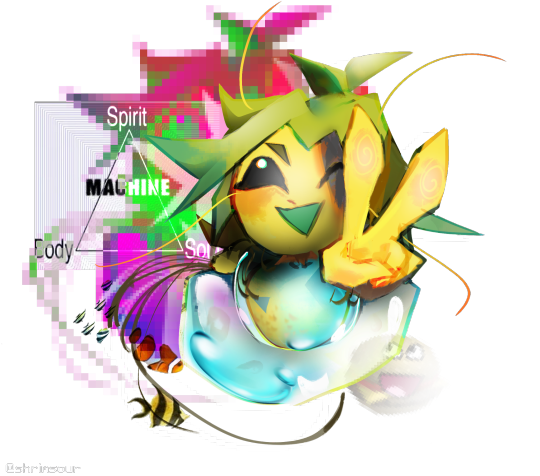
She is basically a combination and a love letter to everything I love and everything I am.

She was originally supposed to be realistic and humanoid like Salty herself but I found her a bit too uncanny for a main sona. (And mainly rendering a realistic fish tank everytime I wanted to color in my persona would certainly prove to be hell, I needed something simpler, but also along the way I realized, something DIFFERENT)


Now to talk a bit more about what she actually represents that's so important to me. I packed her full of little things that make me happy.
Obviously the entire mecha genre, everything cyborg, machine, robot, give it to me. Especially if it's uncanny but also sometimes silly, a bit of both worlds.
The era of semi-early internet post 2010s. I hold Windows Vista and 7 in high regards. Things like notations on YouTube seem so far away now nobody knows what I'm talking about when I'm explaining how annoying click Xs on all of them was!

Probably the most glaring thing. The heavy addition of shrimp. I like shrimp. I like eating shrimp, I like watching shrimp and I'd love to have a shrimp cove of my own they are genuinely such adorable and helpful little critters, what's not to love?
Frutiger aero. Self explanatory. The future we deserved.
Nightcore, anime and manga culture during the internet's infancy. Her big beady eyes and poses aim to replicate the artstyle of anime girls from that era
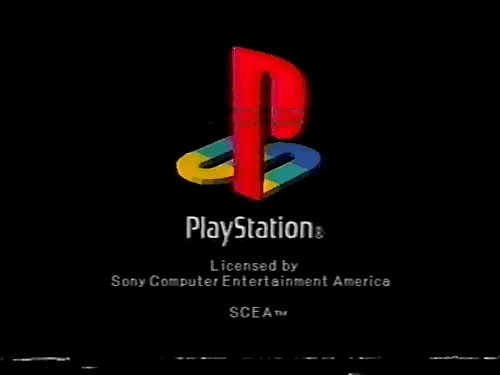
Very old videogame character models. Early 3D model presentations from Nvidia, educational games, etc. I wish I still had my PS2 and PSP
My favorite colors and compelling thought out design instead of that ugly dress/set grey fuckass lookin thing on Saltsour
Divine machinery and uncaniness of computers and machines around us
Big ass black eyes with a shine are also meant to represent the autism creature lol since I very much behave like it often times
Skirt thing - I like wearing skirts, pleated especially
Whiskers, another reference to shrimp but I also think it makes her appear subconsciously like a cat, people love cats and so do I
Triangles. They are the best shape.
These are the first early concepts for Shroomp
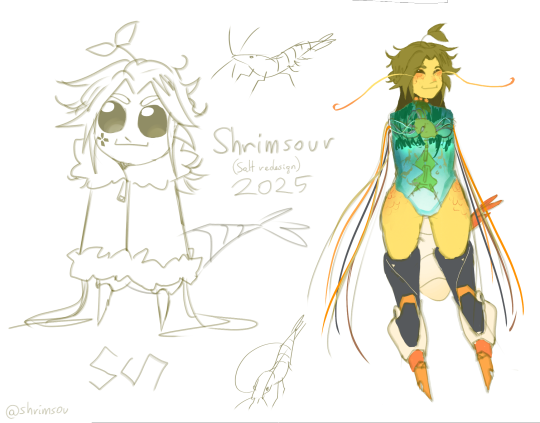

She was meant to be a kreaczure™️ (creature) from the very beginning it was fate
THANK YOU for scrolling and reading so far I'm gen so impressed and thankful. I must've done smth right if I kept ur attention.
Now im gonna put stuff here that most ppl probably look for in a pinned post bc I'm devious
FAQ
Commission status: CLOSED for now
Program: Clip studio paint
Tablet: XP Pen Artist 15.6 pro
Brushes: eee will link soonish maybe remind me if you care
Art tag: #shrimposting for my original works
Old art tag: #saltsour arts for my original works before the rebrand
#saltsour arts#artists on tumblr#art#digital art#digital painting#character design#character art#original character#my persona#persona#my sona#sona art#self sona#let him cook#illustration#rebranding#lemons#frutiger aero#mechposting#mecha#my artwrok#artwork#low poly#nostalgia#early internet#windows vista#divine machinery#intro post#original art#old games
26 notes
·
View notes
Text
there is one thing that will forever bug me about inside out 2
so. lance slashblade.

one of riley's old fictional crushes. the first time i saw him, i immediately knew he was supposed to be from a 3ds game.
probably the biggest giveaway in that regard is the resolution that he's rendered in. the 3ds's vertical resolution for both screens is 240p, which is the same as the nes. it also lacks antialiasing, an effect in which an image or texture, usually a low-resution one, is blurred slightly to mask rough edges. these two characteristics come together to create a pretty convincing effigy of a typical 3ds game.

comparing him to this screenshot of kid icarus uprising, you can see that blocky, aliased look in action.
now, granted, the 3ds usually couldn't support a model quite as high-poly as lance is shown in the film. pit's weird cinderblock-shaped hands are pretty clear evidence of that. even when the 3ds dedicates most of its resources to drawing a single, detailed model with little else going on, it's still somewhat noticeable, as you can see in the trainer battle intros from pokemon sun & moon.

(sorry for using a gamexplain thumbnail it's the only screenshot i could be bothered to find)
however, i'd argue that lance even does a fairly convincing job in that regard.

while he's rendered with a pretty high poly count, his design doesn't seem like one that would be very hard to decrease the poly count on. his outfit, particularly his top, is fairly form fitting, meaning they could be reduced to textures on a relatively simple torso shape. the shape of the hilt of his sword is a bit complex, but it presumably wouldn't be seen that close up during gameplay, meaning it wouldn't hurt too much to sacrifice.
the detail in his face might also be an area of contention. one could argue that making him expressive - overly so, in fact - was more of a priority than making him look accurate to the capabilities of the 3ds. which is reasonable! but also, looking back at the examples of real 3ds games i posed earlier, you'll notice that the two different developers have visibly different priorities. game freak prioritized keeping the rounder body shapes more clear and appealing, at the cost of a flat-looking face. sora, on the other hand, priorotized a more expressive and detailed face at the cost of the rest of the body - notice how pit's head and hands almost look like they come from different console generations. maybe the developers of whatever game lance is from had similar priorities, and wanted to make sure lance's face remained expressive and readable, and as such made sure the rest of his body would be easy to downscale to a lower poly count to make room for it.
speaking of which, what kind of game is lance supposed to be from? we've pretty well established his system of origin, but what type of game on that system? a jrpg of some kind?
NOPE. WRONG.

HOME CONSOLE. WIDESCREEN TV. HEAD TO HEAD FIGHTER. FUCK YOU.
14 notes
·
View notes
Text
I tried character modeling :P

I’ve always wanted to create my own characters on 3D, so I decided to try it out and see how it ended. I began by modeling a low poly character as it did not needed as much work as a high poly one.
The design of this character is not original though, I don’t know where does it comes from or who created it. It’s just from a character sheet I found on Pinterest :P that seams simple enough for a fist attempt.

The account I took it from is the following but I’m not sure who is the real creator 🙃
#blender#3d artwork#blender 3d#3d art#3d model#blender render#my shitty art#i spent way too long on this#3d blender#low poly#character modeling
19 notes
·
View notes
Text
Low Poly Dog – 3D Model for Games & Animation 🐶🎮
Looking for a high-quality low poly dog model? This optimized 3D asset is perfect for game developers, animators, and 3D artists who need a lightweight yet visually appealing dog model for their projects. Whether you're working on a mobile game, VR experience, or stylized animation, this model is designed for seamless integration and smooth performance.
What’s Included:
✔ Optimized low-poly dog model (clean topology) ✔ Game-ready and fully UV-mapped ✔ Compatible with Unity, Unreal Engine, and Blender ✔ Multiple file formats: GLB and Blender (.blend) ✔ Rigged & ready for animation (optional)
📩 Instant Download | Lightweight & Efficient | Perfect for Stylized Games
5 notes
·
View notes
Note
so like, they make these ionic membranes for dehumidifying 3d printer filament boxes... basically by turning water into hydrogen. they're really expensive tho.
we've been thinking if it's possible to make something significantly cheaper, and we think we have come up with something. it uses the same principle of electrolysis, but instead of a solid membrane, it uses a liquid. specifically, sulfuric acid is really good at pulling moisture out of the air, down to very low relative humidity, and it's also really good as an electrolyte for electrolysis of water, enabling you to do both processes simultaneously. and unlike the very expensive membranes, which fill the filament box with oxygen gas, you can pipe out both the oxygen and the hydrogen, reducing the risk of explosions and fire.
only problem it might react with the filament. someone would have to try it and find out. what do you think?
Most of the industrial sulphuric-acid based tank dryers are whole external systems that pipe air through the acid side in a separate container pretty far from the tank contents to reduce the opportunity for interaction between the tank contents and acid, so unless you do that it would probably be hard to get the concentration high enough without having loose acid vapour eat your filament.
If you're trying to avoid heat-based drying, I'm not sure this helps, I think the limiting factor on drying at room temperature is a migration rate for moisture out of the filament, not the dryness of the air being used for drying.
There's those solid-state dehumidifier elements which seem like a better idea if you are looking for a very reliable long-term dry holding system and you're willing to go through the equivalent rigamarole of a sulphuric acid dryer.
4 notes
·
View notes
Text
in honor of fantasy high minis going up for auction, I'm remaking them in HF
I'm only doing them as they go up for auction though I have a paper to write.
this week (3/4) we got Adaine, Kristen, and Fabian on the Hangman.
3/11 oops i did it again but forgot i already made a post lol
pics & explanations under the cut.
things i can't match perfectly
color. I did my best, but i mean they did the painting bit IRL so some stuff I can't recreate with decals. also eyes are detailed in HF, I just picked what I remember their canon eye colors as being.
faces. HF completely changed how they do faces recently. I did my best but the mini faces are real tiny and hard to see and I'm unlikely to be able to recreate them.
poses. while there's very little advanced posing for these guys, there is some. I picked the base pose I think they started from.
this was actually much harder than I thought, because I had to remember what HF stuff was available way back then and what wasn't.
Adaine Abernant! (auction mini)
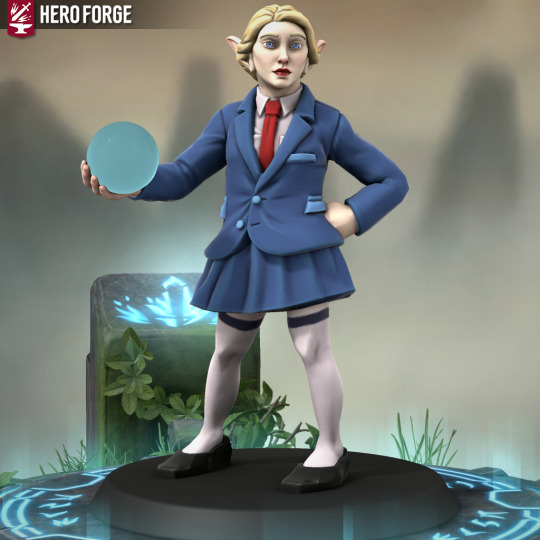
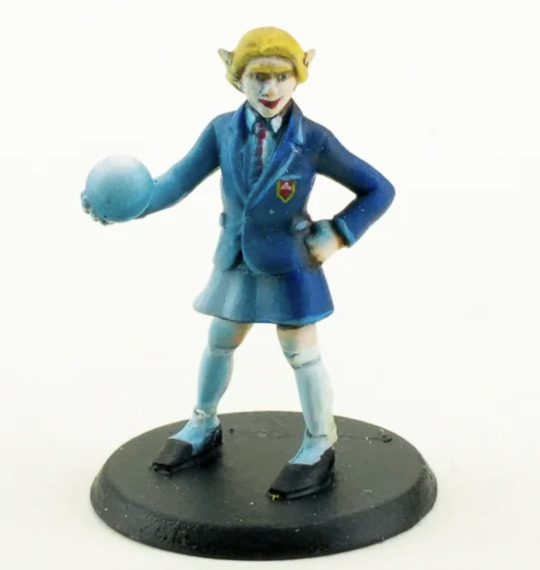
notes:
they made her before HF separated pants/skirts into an upper layer and lower layer, so I have no idea if there were leggings or anything originally. I am almost 100% certain those low poly flats are accurate though.
HF doesn't have socks, so I did my best with decals, but the skirt covers up where the sock color fades into skin color.
surprisingly, Adaine's mini has like. dark red lipstick. its a good look I just didn't notice it earlier.
couldn't get the Hudol decal on her jacket or the stripes on her tie. you can get patterns on the shirt but not on the tie :/
she's not smiling as much bc the 3d printed face isn't smiling that much its just the way the lipstick's painted that does the smiling for her.
Kristen Applebees! (auction mini)
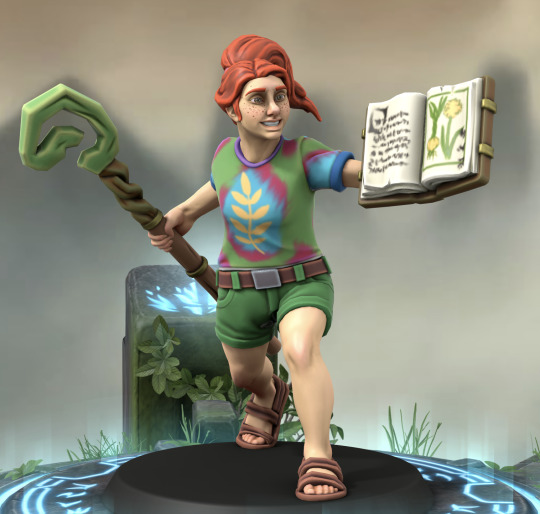

notes
they don't have corn on HF. I think this rotated fern looks OK though. same w her book, I scootched some decals around to try and match the design at least a little.
while they do have patterns for clothes now, they don't have a tie-dye one. this is a heavily modified leopard print. not as many different colors, but the ones that are on there do match the ones on the mini's shirt.
this is one of the few where I think I did in fact get her face right. I copied my old Kristen design from before the face customizer came out, so this is the old "round face" preset.
the freckles are subtler obviously but i s2g they're there and they are reddish-orange
Fabian Aramais Seacaster & The Hangman (auction mini)
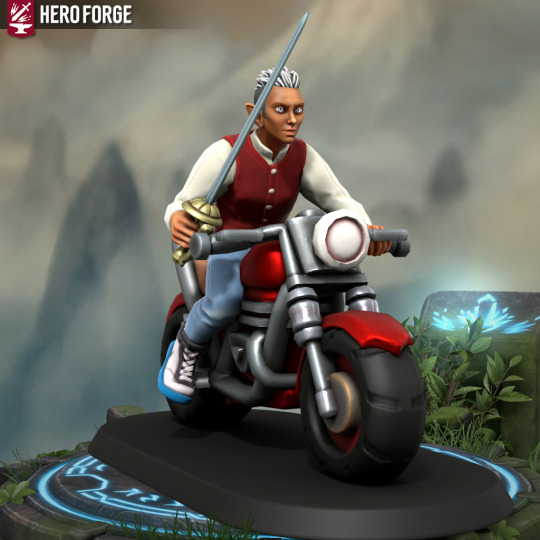
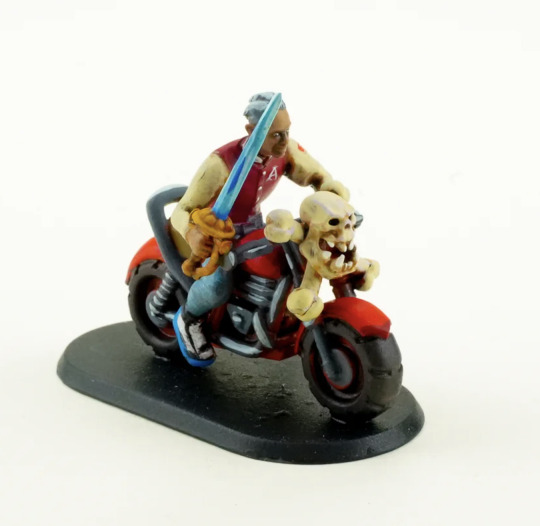
notes
his hair. ooh boy. they did the tiny mohawk and then painted on shaved sides but HF can't do shaved sides like that so I used a truly ghoulish amount of decals to approximate. [update: they have since added shaved head decals and I have updated the boy accordingly]
also he does technically have eyebrows 3d printed on i think, but they aren't painted separately. its just skin color. and that just looked bad and wrong on HF so i took his brows off altogether.
they made the skull themselves, but otherwise it's mostly the same bike. I used the "bloody skull" color for the headlight as a lil tribute.
this type of rapier used to be much chunkier, whatcha gonna do. I like this one better anyway.
they can do decals on the back now but none on just the sleeves, or on the front where the A is. rip.
fun fact: this is not a letterman jacket. This is what's called the "outlaw's shirt and vest" props to the team for resourcefulness, good jackets in HF are relatively recent.
#original post#d20#dimension 20#art#fanart#heroforge#fantasy high#minis#miniature art#miniatures#auction#dnd#this post is quickly going to become a nightmare to load and i apologize in advance
12 notes
·
View notes
Text
Hello I'm Highly skilled artists and technicians specializing in creating custom 3D models, mods, and assets for various industries, including gaming, film, and animation. Expertise includes:
- *3D Modeling*: Designing and crafting detailed, high-poly, and low-poly 3D models from scratch, using software such as Blender, Maya, or 3ds Max.
- *Rigging*: Creating skeletal systems for 3D models, enabling realistic movement and animation.
- *Texturing*: Applying detailed textures, materials, and shaders to 3D models, enhancing their visual appeal and realism.
- *Animation*: Crafting animations, cycles, and movements for 3D models, bringing them to life.
- *Modding*: Creating custom mods for games, including asset,amour replacement, level design, and gameplay mechanics.
I'm possess a deep understanding of 3D art principles, software, and pipelines, ensuring high-quality deliverables that meet client expectations.
#modding community#commission someone#commission request#looking for a feeder#batman#vrchat avatar#modded minecraft#beautiful model#3d model#3d animation#2d animation#2d art#furry art#sfw furry#live 2d#sims 4#gaming
3 notes
·
View notes
Text
Hi, I'm Monalisa, a 3D artist and fashion designer with a passion for creating innovative and visually stunning fashion designs. I use my skills in 3D modeling, texturing, rigging and rendering to create realistic and wearable fashion pieces that push the boundaries of what is possible.
In my portfolio, you will see a variety of my work, including:
Conceptual fashion designs: These are my own original designs that explore new and exciting ideas in fashion. I often use Marvelous Designer / Blender / Zbrush / Substance Painter to create these designs, which allows me to experiment with different shapes, textures, and colors.
Collaborations with fashion brands: I have worked with a number of fashion brands to create 3D renderings and Game assets of their latest collections. Some brands are ( Gucci, Aespa, Crocks, Pacsum , Universal Music ).
Game Assets: I also create high quality low poly 3D assets for games such as Roblox , Decentreland , Second Life and The Sims.
AR Fashion Designs : In collaboration with DRESSX, I've created several AR fashion assets for their try-on app and shopping service. This including NFT limited collections and collaboration with multiple fashion designers. ( please see portfolio archives for previews )
I am always looking for new challenges and opportunities to use my skills to create innovative and beautiful fashion designs. If you are interested in working with me, please contact me at [email protected] .
2 notes
·
View notes
Text
Gamedev Blog #1: Playstation 1 aesthetics and the unreal engine. + Game tease
Unreal engine 5 has been pushing the limits of real-time rendering. But some of us, myself included, have gone WAY back to rendering chunky, blocky PS1(PSX) styled graphics.
The tip of this spear is the Gorgeous Goth Goddess @b0tster with their twofold Bloodborne PSX and Bloodborne Kart projects respectively.
The reasons we choose the style are simple. Firstly those of us who are leaning hard on this aesthetic were in our formative years during the fifth console generation, so we have fond memories of playing games that look CHUNKY. And secondly, perhaps most importantly, it is the easiest (kinda) 3D content pipeline to do as a solo developer.
No need to bake meshes, no polygon budget, no texture streaming budget, Installs that won't even approach 100 gigs(let alone 10g), and guaranteed 60fps is a minimum. Low poly art style has a lot going for it.
-Getting the style
The Unreal engine 5 does have to be modified a little bit. Since it has features that were not even dreamed of in 1998 set as default, We actually have to use a shader to emulate the lower fidelity colors, resolution, and lighting effects. Starting the project means turning off things like: anti aliasing, motion blur, HDR lighting, ETC.

My current post processing effect.
Since most people aren't playing on old Sony CRT tv's and have modern 16:9 monitors, we have to just divide the HELL out of the resolution and color space. This shader (shown above) is very adjustable, and is just the first step on the PSX-esque look.
The next step is modeling and texturing. I'm used to 3d modeling in high resolution, so I had to learn to think like a 90's developer and get as much detail as I can squeeze out of as little polygons as possible.
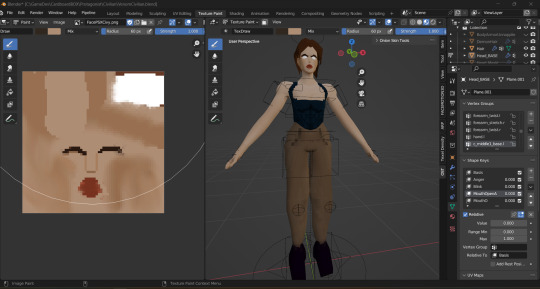
A WIP of a character in my upcoming project
High polycounts give artists the freedom to make their characters as realistic as possible, BUT making them look exactly right, and more importantly animate in a way that looks real is hard to pull off. Low poly models require much more precise and EXACT modeling and texturing, but allows for a more artistic interpretation of how characters look and move. The human eye is more forgiving of caricatures of people.
youtube
Another popular effect for most PSX throwback games is the model "jitter" where models would not place vertices in their EXACT location on the screen(check out the video above!). So it looked like the character was shaky until the camera got right next to the character, to save on memory. I am currently debating using this effect in my game.
The game
So the game I'm working on is: Codename Cardboard Box. (the title is pending some stuff)
As you can probably surmise from the codename it is a metal gear solid homage. I will be taking the Tactical Espionage Action gameplay, and long stylized cutscenes of the serries and putting my own spin on it.
I have been playing through the whole serries recently(again lol), and have noticed so many Queer pieces of subtext than I did as a teen. But it seems like there was a heavy censoring hand on the story creators to push that aside, for example in MGS 2 there was cut dialogue in the script where Otacon would have mistakenly called Snake "David". Implying a much more familiar relationship. MGS4 showcased a lot more "for the male gaze" designs, and camera angles. (I swear to god Naomi's boobs have more screentime than Meryl in total) and the whole serries seemed to have every woman who talked reinforce gender stereotypes, or was just a non stop flirting machine for snake to banter with. The only one who sort of escaped this fate was Emma Emmerich, but even then there were a few lines that made my eyes roll.
Originally I thought of a mod that would change the genders of all the main characters of the MGS serries, to make it way gayer. But then I thought, firstly, Konami is quite litigious, and that I don't think that changing the voices and character models would do much to the overall queer representation and messages of the story.
So Codename Cardboard box (CCB) is going to be an original new story to represent what it is to be queer in the world right now.
The style I am going for is pretty specific, not quite 1:1 PSX or N64 in graphical fidelity. More like a step between Metal gear solid 1 and 2 as a port to the PC in 1999.
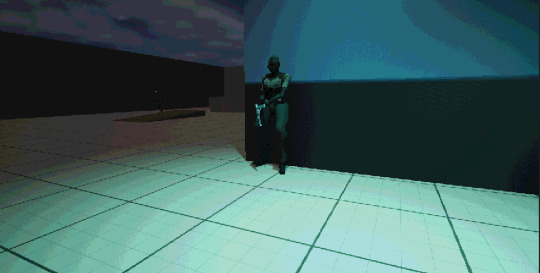
Hopefully I can capture the exact aesthetic, I'm still experimenting between MGS 1 style and MGS 2. I don't fully want to commit to one or the other. So I'm toying around between super low textures (64x64-128x128 max) of MGS1, and the medium detail models of MGS2 (with eyes and a single mesh). This is what I have landed on so far, but things may change in the near future.
I also will be using more modern real time lighting solutions, as I think there can be some gameplay choices that can be effected by this (darkness being a great asset).
As far as gameplay goes I'm going for a patchwork of mechanics from across the serries. So here is a small list to represent how it will feel to move and attack with the character:
The over the shoulder / top down view toggling options from MGS3.
The 3 stance options (stand, crouch, prone) of movement from MGS4.
The auto aiming from MGS2, with the over the shoulder toggle aim from MGS4. (no first person view, for now)
The ledge climbing from MGS 2.
No Stamina bar like in MGS1.
And surprisingly enough a hybrid of the MGS 1 item selection (where you just have all of your weapons available to select at any time, rather than using a backpack)
And of course some other cheeky mechanics that I can't spoil just yet.
But of course all of these screenshots, mechanics, and ideas are works in progress. While they fit the game now, they may be changed to fit the vision of the game better in the future.
So that is it for blog post #1! I will tease the next update just below, but after that I am going to continue my personal gamedev history below that!
Next time:
Blog 2- animation, scripts, and themes.
So Personal gamedev journey. The most vivid memory I have of making a choice to be a game developer was in the year 2002. I was playing Diablo 2, after completing a multiplayer halo 1 campaign . My friends and I were just in awe of games as a storytelling medium. We had been playing on a LAN connection and were thinking about making our own diablo 2 mod or even whole separate homage game. We all chose roles of what we could do to make the game. And none of them really did anything beyond a conversation. I was enthralled thought.
I dabbled in halo moding (I never released anything, so don't bother looking it up.) and thought about making games through the rest of high school.
After graduation I kind of dropped it while I just kind of goofed off for like 3 years. So in 2007 I took some 3d modeling classes and learned how to use 3ds max at my local community college.
I made a few cool looking mechs, but I remember just not being able to do much with the software. If you don't know 3ds max is not a very good 3d software.
So from 2008 to about 2014 I was a bit of a mess. I didn't really do much with my life as I was a disassociated mess ( see blog post 0 for more info) I just was kind of drifting from one job and activity to the next. Those friends I mentioned earlier started a video production company, we made a few short videos for youtube, never got over 40 views. And we just kind of fizzled out. I was the 3d artist of the team. But nothing really clicked.
I felt trapped, cuz I lived in a super expensive area and with my parents. So of all things I moved to Utah to strike out on my own, where I tried to kickstart a 3d printed miniatures company. (I beat hero forge by a little bit, but they had the more solid everything)
After that the unreal engine 4 came out. I poured more and more time into it. I had 0 programming knowledge and had seen games like braid, and fez become popular. So I started just making stuff. When I found a dead-end due to a lack of knowledge I would then try to educate myself on that blind spot. Slowly I learned, UV unwrapping, animation, sprite art, rigging, and more!
That took all of 6 years off and on. Then one day I decided that I had not gotten my shit together. So I looked inward (once again read post 0) and found that I had ADHD and other hang ups that were causing me to not commit to any one project. So I got medicated, and therapated, and learned how to properly learn. So After about 50 false starts. I'm throwing my hat into the ring again. This time doing it for myself. I'm not going to use this blog as a method of checking in, I'm using it to document my journey. No matter where it takes me.
The goal is to release a game on itch.io and steam. I don't care how many units it sells. I want to release something to have fun, and to see where I can take myself.
I will do some attempts at the social media game, if it finds an audience, awesome. If not. K. My only hope is that a queer person somewhere plays my gay ass game and has a gay ass time.
-thanks for reading this loooong poooooost!.
5 notes
·
View notes
Text
Creating Modular Props for Dynamic 3D Game Environments

In the fast-paced world of 3D modeling games, developers and artists are always looking for ways to streamline production while boosting creativity. One such powerful technique is creating modular props—versatile, reusable assets that form the foundation of immersive and dynamic 3D game environments.
Modular design is more than just a buzzword. It is a production strategy that fuels game development efficiency, reduces costs, and enhances visual consistency. Whether you’re designing a car 3D model, a sci-fi corridor, or environmental assets for an open-world map, modular props are indispensable.
In this blog, we’ll explore the importance, workflow, and best practices for creating a modular props 3D model that elevates gameplay and storytelling.
Why Modular Props Matter in 3D Modeling Games
At the heart of any interactive 3D game environment is a collection of detailed and reusable 3D game assets. Instead of designing every structure or object from scratch, modular props allow developers to use predefined pieces to build complex scenes, just like building blocks.
Here’s why this approach works so well:
Efficiency: Designers can create large scenes quickly using smaller pre-made components.
Consistency: Modular props maintain visual cohesion throughout levels.
Optimization: Reused assets reduce memory load and improve game performance.
Flexibility: Artists can easily update, reconfigure, or animate props to suit evolving gameplay.
Understanding the Role of Props in 3D Game Environments
In gaming, props are objects that decorate the scene or serve gameplay functions—barrels, crates, streetlamps, vehicles, benches, or even modular wall sections. These props 3D model may not always be interactive, but they’re crucial for storytelling and immersion.
In open-world or sandbox-style 3D modeling games, dynamic environments rely on a massive volume of props, from urban clutter to wild forest elements.
Pillars, fences, and wall panels
Road and terrain tiles
Pipes and mechanical parts
These elements bring richness to the scene without overwhelming artists with too many unique asset requirements.
Designing Modular Props: The Workflow
Creating modular 3D game assets isn’t as simple as cutting objects into chunks. It requires careful planning and technical discipline. Here’s a typical workflow:
1. Planning and Blockout
Start by planning the environment type—sci-fi, medieval, urban, etc. What story or gameplay will unfold in that space? Then, block out the level using basic geometry to understand scale and proportions.
Define modular sizes using grid snapping and units. For example, if walls are 2 meters tall and 1 meter wide, all modular pieces should follow this metric.
2. Modeling the Props
Model your props using best practices from 3D hard surface modeling or Hard Surface Modeling, especially for mechanical or architectural objects. Modular modeling thrives on clean geometry, straight edges, and seamless alignments.
Use edge loops, bevels, and consistent topology for smooth baking and texturing later.
3. UV Unwrapping and Texturing
Keep UVs clean and consistent. Modular props often share the same UV tile or texture atlas to optimize rendering. Use trim sheets for repetitive surfaces like metal beams or pipes.
For texturing, tools like Substance Painter or Quixel Mixer help create realistic materials and surface detail, even for low-poly assets.
4. Optimization and LODs
Modular props need to be optimized for performance. Use polygon-efficient modeling, bake normal maps for high detail, and create Level of Detail (LOD) meshes to support different view distances.
A detailed 3D vehicle modeling asset, for example, should have high-res and low-res versions, depending on the camera proximity.
5. Exporting and Engine Integration
Once your props are ready, export them into your game engine—Unreal Engine, Unity, or others. Use naming conventions, pivot points, and snapping coordinates to ensure smooth assembly.
Import the props into prefabs or blueprints for modular scene creation and in-game logic connections.
Hard Surface Modeling for Modular Props
3D hard surface modeling techniques are essential when crafting modular props. Think of industrial corridors, pipes, or vehicles—these require precise, mechanical geometry with clean lines.
Hard surface props benefit from:
Boolean modeling for cutouts and panel details
Decal workflows for adding dirt, labels, or damage
A modular car 3D model might include detachable wheels, doors, and interiors that you can reuse across game levels or repurpose for different missions.
Dynamic Use of Modular Props in Game Environments
The same prop can serve multiple roles in a game depending on placement and transformation.
1. Environmental Storytelling
A broken lamp post can suggest a recent battle. A rearranged set of crates might form a barricade. With a library of modular 3D game assets, level designers can create narrative depth through environmental storytelling.
2. Procedural Generation
Many modern games use procedural systems to generate levels. Modular props feed directly into this workflow, allowing infinite combinations without manual design. Dungeons, cities, or terrain can be created using algorithms powered by modular components.
3. Real-time Gameplay Adjustments
In dynamic games where environments shift—say, an earthquake collapses a structure—modular props make it easier to trigger environmental changes without reloading scenes.
Best Practices for Creating Props 3D Model Libraries
To maximize the power of modular props in 3D game environments, follow these best practices:
Use consistent naming conventions: Makes large libraries manageable.
Test frequently in-engine: Always verify snapping, alignment, and performance in your target game engine.
Future Trends in Modular 3D Game Assets
As 3D modeling games evolve, so do the demands on asset creation. Here are some upcoming trends:
AI-assisted prop generation: Tools that generate modular pieces based on concept sketches or prompt-based inputs.
Photogrammetry-based modular kits: Real-world scanning converted into modular prop kits for realistic environments.
Cross-platform asset reuse: Modular props optimized to work in both mobile and console versions of games.
Additionally, industries like automotive simulation and metaverse development are adapting modular 3D vehicle modeling techniques to reduce build time and enhance flexibility.
Conclusion
Modular props 3D model creation is the backbone of efficient and engaging 3D game environments. It empowers artists to build rich, dynamic worlds from a relatively small set of reusable pieces. By mastering 3D environment modeling, following hard surface modeling principles, and maintaining a structured workflow, game developers can reduce asset production time and deliver high-quality content.
Whether you're crafting a futuristic spaceship interior or a bustling city street filled with car 3D models, modular props offer a creative and technical advantage that no game development pipeline should ignore.
#3d game environments#game assets#3d game assets#3d modeling services#hard surface modeling#props 3d model#3d vehicle modeling
0 notes